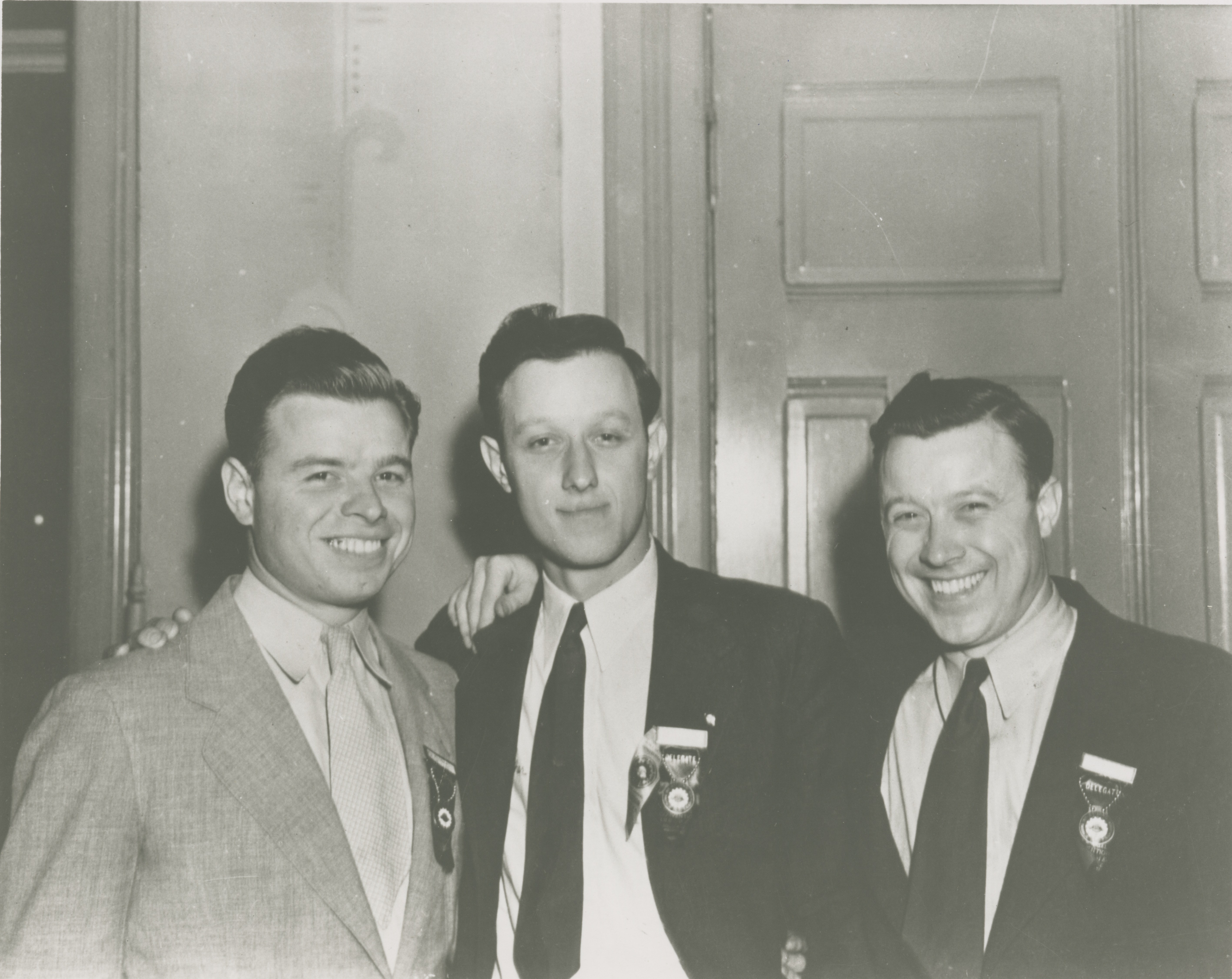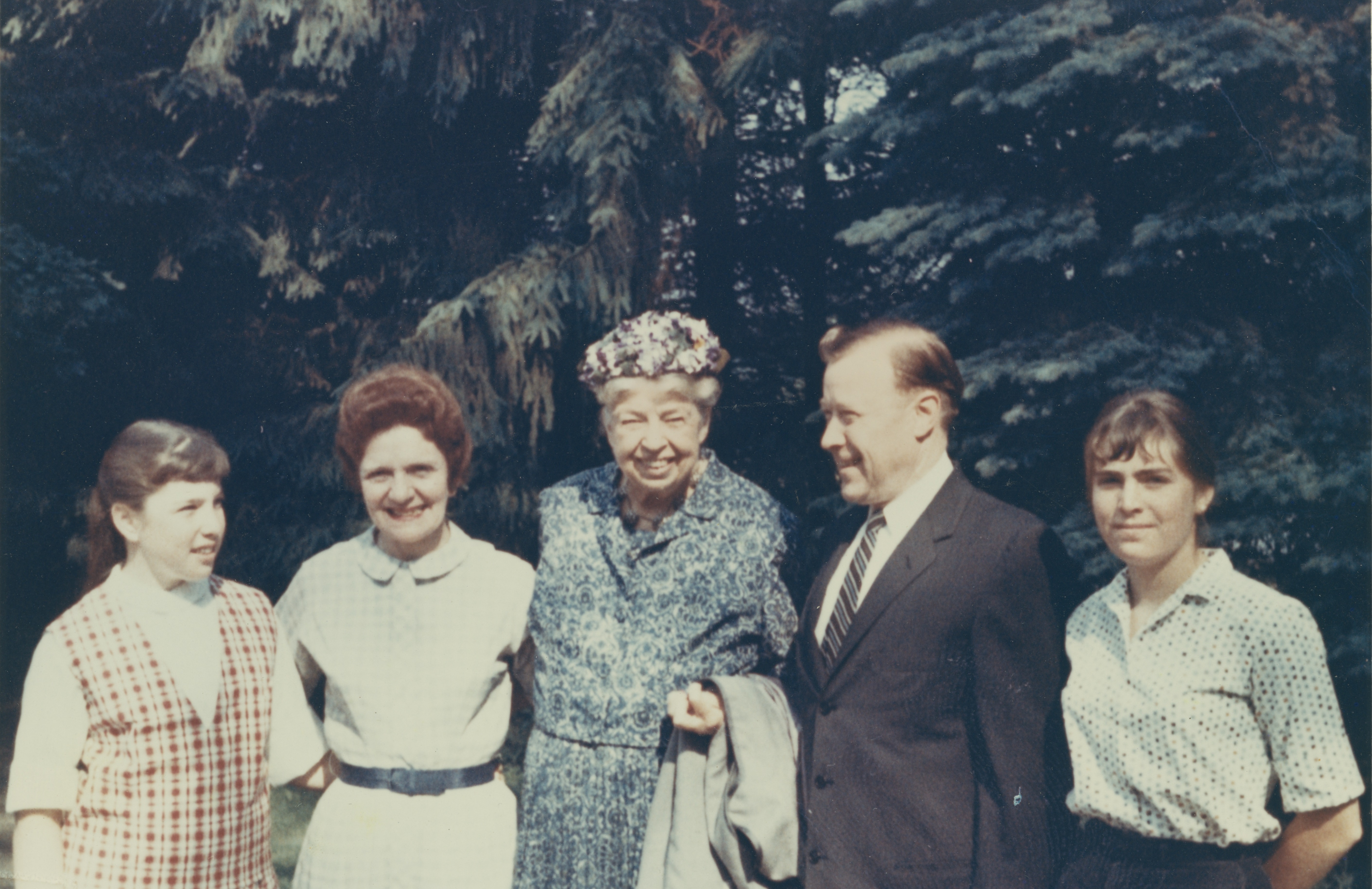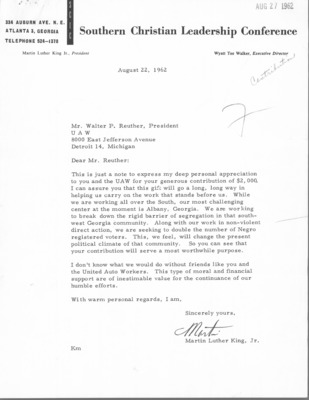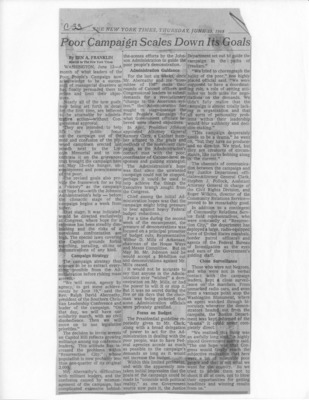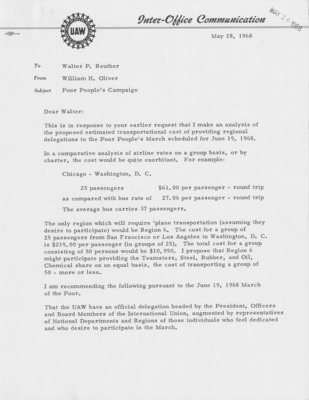UAW Solidarity
Item
- Title
- Date
- Alternative Title
- extracted text
-
UAW Solidarity
-
1959-08-01
-
Vol. 2 No. 8
-
Sk ERAS OCI
1
re oe
5
Big Steal: Huge Corporate Profit
The
return and explode on the
launching pad when corporations were forced to reveal
space age profits for the
first half of 1959.
big
management | -s had trained
on labor, in the fear-inspiring name of inflation, veered
off its course this month to
The missile, lLnowing its
‘target better than its launchers, blew the corporations’
argument against labor out
of this world.
current
because
the steel industry had appointed and anointed itself as the Messiah to save
3-5-8 Edition
UNION, UNITED AUTOMOBILE, AIRCRAFT & AGRICULTURAL
INTERNATIONAL
Vol.
Second
class
ensitssatnd
at
$00
EE.
postage
Jefferson
2457
E.
paid
Ave..
at
Indianapolis,
Detroit
14,
2,
Ind.—EDITORIAL
Mich.—5e
Washington
shingten . St...
St., Indisnapols
a
@,
copy.
Ind.
No.
OF AMERICA-UAW
IMPLEMENT WORKERS
August,
8
OFFICE
Published (100%
POSTMASTER:
4, KuMIONDE CORINTED
YE =
Send
undelivered
directly under mailing label
POSTAGE
7, Ind.—RETURN
copies
with
Form
te 2457 E. Washington
GUARANTEED.
1959
3579
St.,
attached
Indianapolis
Map
UAW-IAM
Aims in Aircraft.
KANSAS
CITY, Mo.
representatives
Union
of
600,000 aircraft, missile and
related electronics workers
shaped up a new, basic collec
tive bargaining program
here this month.
|
In a_precedent-setting 3day meeting, some 400 delegates to the first Joint
for
Conference
UAW-IAM
the industry’s workers overwhelmingly adopted the 7point program targeted at
their negotiations with every
major employer in the industry beginning next Spring.
A milestone in American labor history, the get-
together
drew
delegates
from UAW
and Machinists Union aircraft, missile
“and related electronics locals throughout the US.
and Canada and from as
far away as Hawaii. It
marked the first time two
of the nation’s major
unions have joined in such
a united effort.
Concentrating on develop- ing their joint program, the
conference
also heard
the
problems of aerospace work-
ers discussed by UAW Pres-.
Reuther,
P.
Walter
ident
Al Hayes,
IAM’ President
Vice-President LeonUAW
director of
ard Woodcock,
the union’s national aircraft
department, and, IAM Vice-
President
Roy
Los Angeles,
Here
are
M. Brown
Calif.
the
:
seven
major
Theactual
pay
boost to be sought will be
this year
later
determined
by the IAM and UAW. But
UNITY of two great unions is symbolized as UAW President
(left) and IAM President Al Hayes raise
Walter P,. Reuther
the joint ¢ aircraft conference.
handclasp in greeting delegates to9 the
-.
3
knee F..
on
nued on
Contites
. y Pon
ab
nf
Co
es
ad
Tr
d
le
il
Sk
e
e
k
u
a
Milw
Plans Strong, Progressive Program
Be
MILWAUKEE—
ination
marked
the
hy
Determ-
actions
of almost 800 skilled tradesmen at the seventh annual
UAW
skilled trades conference to make this a mean-_
ingful meeting aimed at implementing a program for
strengthening
rights
the
tions for journeyman status in all plants.
Uniform apprentice
e
training schedules in all
plants.
Skilled trades supe
plements in all union
of
improving
and
craftsmen
conditions throughout t h e
industry,
Skilled tradesmen pledged
themselves to work for these
goals.
@e
Standard
agreements.
Uniform
e
qualifica-
rates for
engaged im
all tradesmen
similar work.
by
Chaired
Vice
UAW
President Richard T. Gosser,
director of the union’s skillthe
ed trades department,
conference hammered out
some 21 resolutions during
the three-day sessions. These
were aimed
at helping to
achieve
the program
outlined above.
Last February, the international
executive board
(IEB) revamped the entire
skilled trades setup.
The
IEB abolished regional skilled trades councils in a move
to. strengthen
the
skilled
trades structure, and established a nine-man advisory
committee to work with the
board. This was expected to
make the skilled trades section more responsive to the
needs of tradesmen.
FORMER
PRESIDENT
HARRY
S.
TRUMAN
illustrates
a
story
a
for
of
group
Ray
he
had
conducted
them
through
the
famed
Truman
Library
at
Ross.
MHUUTUNUAQQQUOORUO400HUUCL4000UTEUUUOQEUUGUATEEUULOUEUUOQUUOTOUCUAUU DOT EEARAOTODOEYY GRU
TEUT TO
UENO
Elected to the advisory
committee
to
represent
their respective bargaining groups were: Ford—
visitors
Left
Mo.
UAW
Independence,
UAW
Truman,
to right are Region 5 Director Ted Hawks, Vice President Leonard Woodcock,
President Walter P. Reuther, Assistant Region 5 Director Ken Worley, and Region 2A Director
after
>
i
ig...
at |
Pics:
ote
_eg<cm
2
Se
oe
turns started coming in,
e
=
#
all—in size, in pri(
J
©
,
lea
which
Steel,
tw
2
y
a
s:
setting, in the drive to Ae
lyze collective bargainin
and in profits—had a good
case, a fine case—for the
United Steelworkers of
America.
This industrial behemoth
rang up a record profit of
more than half a billion dollars before taxes in the first
six months of this year, the
highest half-year of profits
in its entire history, which
has seldom been sullied by
low profits.
this leader of the
And
pack pointing the accusing
finger at labor matched its
total dollar volume of profits
with another record — percentage of profits on sales:
10.1% after taxes; 20.796 before taxes.
Which means in plain English and simple arithmetic
that consumers were contributing to the profits 20.7c
for every dollar’s worth of
steel they bought.
William Rossi, Local 600;
General Motors — Ed
Moore, Local 326; Chrys-
ler—Evan Lininger,
|
Continued
on
Page
Local
6
splendid but lonely isolation.
around,
right
Bivouacked
lending warmth and comfort
and company, were the next
three largest steel producers
and
Republic
—Bethlehem,
_
Jones and Laughlin, who had
extracted enough money from
Americas
of
pockets
the
consumers to chalk up their
own record high profits.
lie
completely
figures
These
management’s
labor costs
eurrently
are
high
the
steel
on
Continued
claims
cause
that
prices
Page
be-
of
and
§&
UAW to USW:
You Have Our
Solid Support
The strong bond of solidarity between the UAW and
the United Steelworkers of
America was expressed in an
by
of telegrams
exchange
the presidents of the two internationals as some 500,000
to
continued
Steelworkers
walk the bricks in a strike
forced by a_profits- “greedy
industry.
* In
a wire
to Steelwork
President :
ers
J. Mc
David
Donald, U A W
President Wal
ter P. Reuther|
pledged “full
undivided
and
|
support,” and
the McDONALD
charged
steel industry ‘‘continues to
follow a blind and selfish
deny
would
policy which
both workers and consumers
their equity in our develop-
ing economy.”
In his reply, McDonald ex-
pressed gratitude for Reuther’s message and added, “We
always know that the United
Auto Workers stand ready
to aid fellow unionists in
time
of crisis physically,
morally and financially.”
TEA
See
pp.
4, 5
¥
%
e
;
a
= -
=
iy
Seee.
5tae
C.
to
Souparity CAMERA: One Summer MontH
ze nc
&
ypach
Omri t
QO =n
zr
O
o
ae
direction as the profit r
them
,
$e
%
s
p
g
e
h
t
in
=
3
&
e
th
in
ked
loo
ple
peo
people looked
mo10st st
U.S.
.
_
U.S. Steel did not iene
to dwell on this icy peak
of stratospheric profits in
of
sections:
1. WAGES,
to
SAU TTA VTA NETUAVATTTTTTN
missile
guided
.
inflation
from
/
4+. QwoMmpys
.
consumers
es
oe :
e
Because of the
steel
strike and
6
i.
_ ee
gsr
5
At 9:08 a.m. Saturday, July 25, a lot of memories began
mingling with the dust of bygone years.
3
At that minute, the first of the five giant smokestacks
towering over the old Ford plant at Highland Park, Mich.,
was toppled by a demolition crew. The remaining four were
torn down the next day.
The auto industry labor era they had come to symbolize
had ended years before. But auto workers came to look
upon them as a constant reminder of what conditions were
like for workers before UAW was organized in the vehicle
|
plants of the U.S. and Canada.
Actually, the Ford company is staying at the Highland
Park site which it began occupying in 1910. Tearing down
the huge stacks is part of a Ford building modernization
program that. will add 153,000 square feet of manufacturing
space for the company’s tractor division there.
The old plant, too, was up-to-date when, housing the
world’s first modern assembly line, it’s new, endless chain —
conveyor growled into operation in 1914. Modern and upto-date, that is, except for the horse-and-buggy attitude it
had toward its workers.
“Every Ford worker is perfectly aware,” two engineers
commented the following year, ‘‘that he is under constant
observation and that he will be admonished
low the fast pace of the department.”
if he falls be-
Fast pace was an understatement.
Machines and operations were speeded up as much as 100% to 200% ata
time. The work was kept moving at a rate remindful of
the
mechanical
rabbit
kept
scurrying
along
just in
front of the speeding greyhounds. And with output steadily
stepped up, pay was frozen at $2.34 a day.
Henry Ford himself admitted workers left his plant by
the thousands.
They couldn’t stand the gruelling, body-
weakening pace.
But when the Highland Park workers
tried in 1913 to form a union, police were called in to cart
away organizers and leaflet distributors.
The workers’ threat to organize was met by Ford with
the announcement that wages were being raised to $5 a
day. That brought a mob of 12,000 job-seekers to the hiring gate. Held back by police that icy winter morning,
tempers flared in protest against being pushed around.
When the crowd began to battle to get through the doors,
police turned fire hoses on the job-seekers.
“They
Journal.
were an unhenviable
‘““Their clothes froze
lot,” reported the Detroit
the moment after they en-
HERE
countered the business end of the hose.’’
Not everybody got the $5 a day. Most women didn’t.
Unmarried men under 22 didn’t. Married men involved in
ARE
SOME
of the
photo
memories
of the
old
Ford
Highland
Park plant—the constant monotony of the same motions, minute after
minute, on a “line,” work being pulled along by an old-time conveyor, and
the finished car rolling off the end of the line outside the plant.
divorces didn’t.
Probationary workers didn’t.
Workers
who lived “‘unworthily” didn’t. Workers who sent money
home to the ‘old country’”’ didn’t. Moreover, any worker
getting the $5 a day who later was caught in one of the
long list of prohibited activities had his pay cut in half.
For a Model T era, it represented years of a horse-andbuggy attitude toward people — with the workers harnessed in place of the horse.
at the plant before the
Ue
®
;
°
—
as long
about
as I worked
UAW,
though.
there
A
and
about that plant. You can’t work in a place
not have
lot of people
past. Our union, it looks forward.”
memories.
look
back.
I'll tell you something
Our union
changed
the
John Banco,
a retired Ford worker
SrHUAQUAUAUANUUUUAUUUUNUUALUUEUEUEUEUNEHUCUUEO000
0000400000000 00 0000 0000O0ROOUEUOGUAUOGUUGUAUUOGUL-UUOEEEUUEELEEEEEEEEEEEEUEUONUEUEUUEGEEUEEEREEUUUEAUUAUANEUUELEEENEEUUUUUUUEELUERERELUEEEUHEY
i
‘Sure, I’ve got memories
—
%@
_ Ask any old-timer who worked
union.
POP 882048.
eee e ee ve eee es
:
INDEPENDENCE.
|
Missourt
“7
DURING
the historic
IAM-UAW
Joint
Aircraft
Conference, UAW President
Walter P. Reuther took a
couple of hours for a visit to
an important part of American history—the famed Truman
Library
at
Indepen-
President Harry S. Truman
conducted a tour through
ard Woodcock,
union. Officials.
and
other
7
In Mitwaukee.Wis
UAW
Vice
tradesmen
President
from
Richard
T.
many
Gosser
sections
(upper
of the Ul
Tfefty, dir
UAW’s seventh annual skilled trades conference to fors
delegates, plus some 175 visitors, officers and staff me
welfare and working conditions of skilled workers, and
conference speakers were Vice Presidents Norman M:
LPNS SSS
99.008 88
of
skilled
A MIL
Joint IZ
aircraft
time tw
bargain
eram a
at the s
"S —
9W g
ses
SOLIDARITY CAMERA
UNIon Montu THis SUMMER
~
|
In Ortawa, [iunots....
Ottawa
eating,
Union Center had lots of fun playing ball,
working, reading and just plain relaxing.
Wisconsin
ns of the United States and Canada—under
the guidance and direction
er left); director of the union’s skilled trades department—utilized the
rence to forge a stronger program for the union’s craftsmen. Almost 800
ind staff members, made it plain they wanted to promote the rights,
Among
orkers, and weld stronger bonds with production workers.
Norman
Matthews
(center
at left)
and
Pat
Greathouse
(lower
left).
IT WAS a grand day for a
picnic—and more than 15,000 turned out in Detroit for
the retired workers picnic to
have a wonderful time, and
hear the inspirational
speeches made
by UAW
President Walter P. Reuth-
er. and
Secretary-Treasurer
Emil Mazey
(shown below
addressing the tremendous
crowd). Yes, it was a great,
golden day for those gentle
folks
whose
golden’
years
have been made much more
comfortable by the pensions
and other benefits won by
the UAW.
N
Kansas
City,
Missouri...
A MILESTONE
Joint LIAM-UAW
IN American
Labor.
Conference at Kansas
History — that was
City, Mo., this month
aircraft, missile and related electronics workers.
Marking
the first
time two major unions brought delegates together to jointly
bargaining goals, the Conference hammered out'a 7-point
gram
as the
unions’ target
for 1960
(story
on page
the
for
map
pro-
1). Speakers
at the get-together were UAW Vice-President Leonard Woodcock,
IAM Vice-President Roy Brown, UAW President Walter P. Reuther
and LAM President Al Hayes (photo at upper left).
- Item sets


